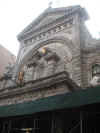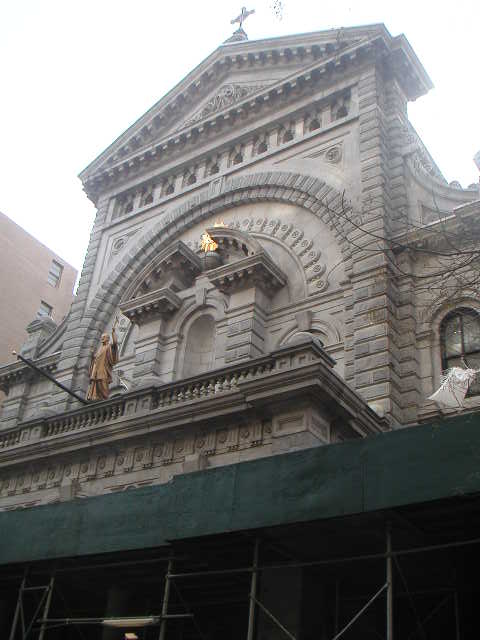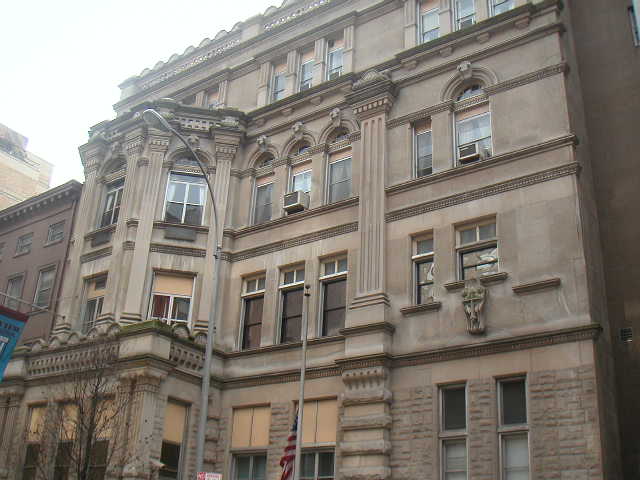|
STREETSCAPES/
West 16th Street; A Side-Street
Surprise: A Monumental Church
By CHRISTOPHER GRAY
Published: March 27, 2005, Sunday
A TRIP down almost any street in or near Chelsea will yield some little
surprise: a weathered decorative rope molding on a brownstone, a sagging
but still grand loft building, a little private stable. But on West 16th
Street between Fifth Avenue and Avenue of the Americas, the surprise is
colossal -- a grand baroque church in granite, struggling against the
confines of its narrow block like a giant in a kindergarten chair.
It's the 1882 St. Francis Xavier Church at 30 West 16th Street, an
architectural muscle show in carved granite, where the parish is now in
the middle of a $6 million restoration, inside and out.
In 1847, the Jesuit community in the village of Fordham, then part of
Westchester County, established a school and church in Manhattan. Within
a few years it built a simple, classical-style church on West 16th
Street it called St. Francis Xavier, with land running back to 15th
Street. St. Francis Xavier grew, and in 1882 the parish put up a new
sanctuary that dwarfed not just the original complex but the neighboring
buildings as well.
The massive portico rushes out to the building line, aggressively crowding
the passer-by. The rest of the church erupts from a relatively sober
ground-floor facade into a wild assemblage of rough-cut granite blocks
stacked one atop another, rising in piers on each side and, in the
center, curving around to make a great central arch.
From within the large arch projects a smaller arch, cut in half -- it's
called a broken pediment. Above, there's a more conventional triangular
shape with heavy carving, called a tympanum. The entire assemblage is
huge and stunning, big enough to dominate a moderate-sized square in
Paris, let alone an undistinguished Manhattan side street.
The church was designed by the Irish-born Patrick Charles Keely, who had
worked in his father's architectural office and, in 1841 or 1842, while
in his 20's, emigrated to the United States. Little is known of Keely's
early life or training, or that of his father. Either architect may have
been university-educated or self-taught.
The younger Keely designed hundreds of Roman Catholic churches -- a level
of production not often consistent with high aesthetic aspirations --
and many of his designs vary only modestly from one another. So St.
Francis Xavier Church presents something of a question mark for those
who visit. Is the exterior a lugubrious assemblage of wildly contrasting
elements by an untutored designer, or a deft collation of historical
references by a master?
''The A.I.A. Guide to New York City'' by Norval White and Elliot Willensky
(Crown) doesn't take sides on the issue -- it simply calls the church
''monumental.'' A Web site,
www.keelysociety.com , is
devoted to the prolific Keely, who died in 1896.
The exuberant cut-stone exterior might be a Parisian opera house or train
station but, for lack of a better word, is usually described as baroque.
But it hardly follows the typical model of that 17th- and 18th-century
movement, which is relatively classical and restrained, at least
compared with Keely's facade.
The interior, although still colossal, is more conventional. In 1884, The
New York Tribune called it ''sumptuous and exhilarating,'' a giant Latin
cross with a high domed crossing, covered with coffering, carved plaster
ornament and scene paintings, all as rich as a cream sauce. One notable
departure from the usual are the windows at either end of the crossing.
Instead of figural religious scenes, they contain pure geometric shapes,
lush and highly colored, with a pre-Raphaelite character.
Thomas Fenniman, an architect working on the restoration project, says
that the stained glass was made, and perhaps designed, by Thomas and
John Morgan, each listed in city directories of the day as a
''stainer.''
Over time, the complex of St. Francis Xavier saw an expansion that
included the chunky Victorian school annex to the east built in the
1890's, itself partly demolished in 1960 for a blunt modernist building
by Joseph Belfatto. A parish history done in 1985 says that a developer
offered to buy the complex in 1971 to turn it into an apartment-house
development. But the church survived the effort.
It is just finishing a $2.5 million exterior repair. Michael Hourihan,
chairman of the building committee, says that the exterior required
extensive work and will ultimately need more. Although granite is
usually a reliable stone, he says that this vein was defective, and that
the church has already had to replace about 5 percent of the units.
Mr. Hourihan says that the church, which has about 3,000 parishioners,
will start a $3.5 million interior project this spring that includes
mechanical and electrical work; pew, floor, lighting and plaster repair;
and related items. The plaster walls are not obviously soiled, but the
original white and ivory coloring has become more like café au lait,
void of the sparkling magnificence visible in early photographs.
Mr. Fenniman says that ''we don't want to make it look like new,'' but he
points out details that have been lost over time, like some Victorian
stenciling in a side altar, barely visible through a later coat of
paint, and triangular inset panes of leaded glass, long ago sealed
over.
Few visitors are allowed up to the gallery running around the sanctuary.
With a second-floor catwalk to the school next door, this balcony was
meant to provide direct access for Jesuit priests and students to
celebrate private Masses, separate from the public. Long abandoned, the
dusty space is surrounded by light and overlooks the magnificent
interior like a box seat at the opera. But it is cluttered with
Christmas decorations, supplies and boxes.
On a recent morning, the sun streamed through the east windows as a lone
worshiper knelt in a rear pew. Suddenly the street doors opened, and a
clutch of visitors stumbled in, looking like tourists just off a bus in
Times Square. Swiveling around, they took in the surprising majesty of
St. Francis Xavier in hushed tones.
As it turned out they were not from St. Louis or St. Paul -- they were a
group of New Yorkers who volunteer for the organization Big Apple
Greeter. One volunteer, Arnold Strauch, said that about 400 greeters
give free one-on-one tours to visitors to the city, and that he and his
companions were methodically walking 16th Street from 11th Avenue to the
East River, scouting to expand their itinerary for future trips. When
they found St. Francis Xavier, he said, they first noticed its grand
exterior, and then walked up the steps to the sanctuary.
Mr. Strauch and his company, swiveling around the majestic interior,
looked as if they had hit the jackpot. ''I never expected to find
something of this magnitude on a little side street,'' he said.
Published: 03 - 27 - 2005 , Late Edition - Final , Section 11 , Column 4 ,
Page 10
|



